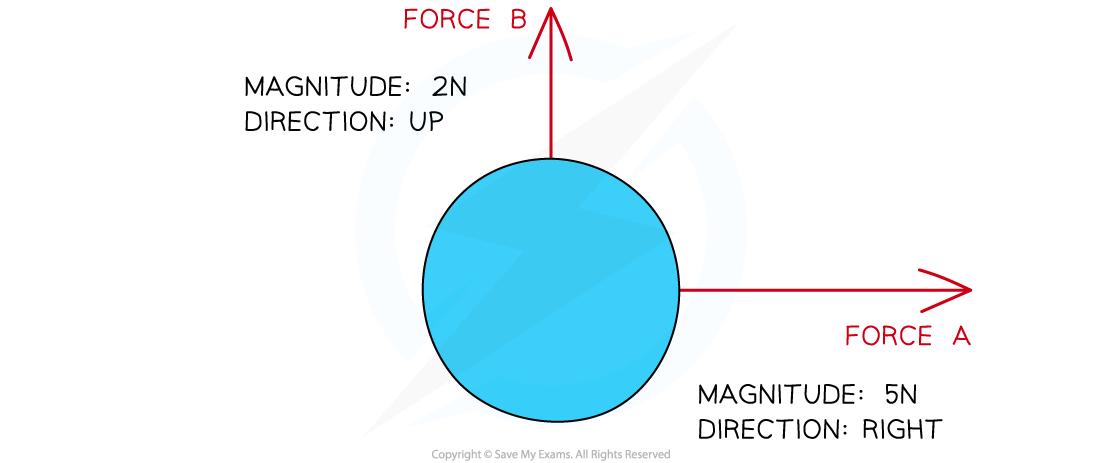Forces, Movement & Changing State
There are three main ways in which forces can affect bodies:
- Changes in speed: speeding up, slowing down
- Changes in direction: change the direction of travel
- Changes in shape: stretching, compression, deformation
There are seven main forces. These include:
- Gravitational: force between two objects with mas
- Electrostatic: force between two objects with charge
- Thrust: force pushing a vehicle
- Upthrust: upward force on objects in a fluid
- Air Resistance: force of friction between objects falling through air
- Compression: force squeezing on an object
- Tension: forces stretching an object
- Reaction Force: force between two objects in contact
\
There are two types of force:
- Scalar
- Vector
A scalar force is a quantity only having magnitude, whereas a vector is a force requiring both magnitude and direction. Some examples of a scalar quantity include energy, mass and volume, while some examples of a vector quantity include displacement, velocity, force, and acceleration.
When drawing forces, the length of the arrow represents the magnitude of the force, while its direction indicates the direction of the force. Not all of them are horizontal and vertical; some are on an angle.

\
A resultant force (aka net force) is a force describing all forces operating on a body, so it is basically the combined action of all forces on an object. It tells us the direction in which the object will move, and the magnitude of the force experienced. Forces working in opposite directions are subtracted, while forces moving in the same direction are added. If they are equal, then the forces are balanced and there is zero resultant force.
Forces can combine to produce both balanced and unbalanced forces. When they’re balanced, they cancel each other out to have no resultant force whereas when they’re not balanced, there is going to be a resultant force acting upon the object. This force causes the object to accelerate (it may speed up, slow down, or change direction). This relationship is known as F = m * a. Another equation for acceleration is a = (v - u) / t.
Newton’s Third Law states that every action force has an equal and opposite reaction force.
\
Friction is the force which opposes the motion of an object. Friction impedes motion, resulting in heating. It will always act in the opposite direction of the object’s option, and it happens when 2+ surfaces rub together:
- at a molecular level, both surfaces contain imperfections (not perfectly smooth)
- imperfections push against each other
Weight is the force acting on an object due to gravitational attraction. Because of weight, satellites stay in orbit, objects fall to the ground, and objects stay firmly on the ground. The equation for this is W = m * g. The weight an object experiences will depend on:
- Mass of the object
- Mass of the planet attracting the object
Mass is related to the amount of matter in an object, while weight is a force of gravity on a mass. Weight and mass are directly proportional, with the size of the force depending on gravitational field strength.
\
Stopping distance is the total distance travelled during the time it takes for a car to stop in response to some emergency. Its equation is stopping distance = thinking distance + braking distance. There are some factors which can change stopping distance:
- Vehicle speed: greater speed means greater braking distance
- Vehicle mass: heavy vehicle means greater braking distance
- Road Conditions: wet and icy roads make it harder to decelerate
- Driver Reaction Time: being tired or intoxicated increases reaction time
\
Falling objects experience both weight and air resistance. Air resistance increases with speed. The process of reaching terminal velocity, where weight is equal to air resistance and there is a resultant force of zero (no acceleration) on the object, happens like this:
- Initially, there is no air resistance and the only force acting is the weight
- As it falls, it accelerates, increasing speed and air resistance
- Resultant force downwards decreases
- Acceleration decreeases
- Equal and opposite forces and balance, no resultant force
- No acceleration, terminal velocity is reached
\
Hooke’s Law is a phenomenon which states that the extension of an elastic object is directly proportional to the force applied, up to the limit of proportionality. This means that, as more force is applied, there is more extension. The limit of proportionality is where if more force is added, the object extends and does not return to its original shape when the force is removed (inelastically deformed).
The law is the linear relationship between force and extension, represented by a straight line on a force-extension graph. Once reaching the limit of proportionality, it has a non-linear force.
Change in shape is called deformation. It can be either elastic or inelastic:
- Elastic deformation: when objects return to their original shape after stretching force is removed
- Inelastic deformation: when objects remain stretched and don’t return completely to original shape (even after stretching force is removed)
\
\
\